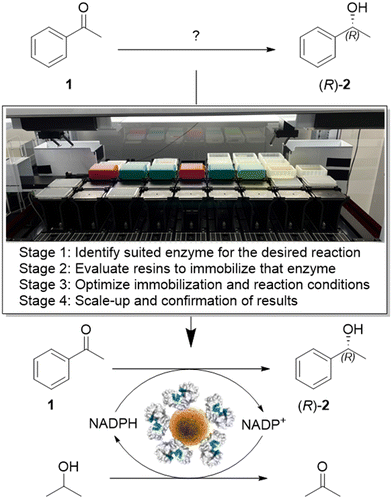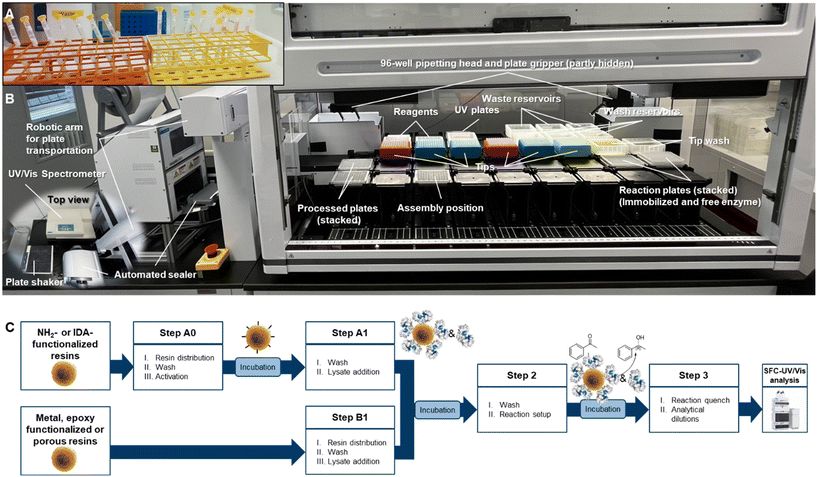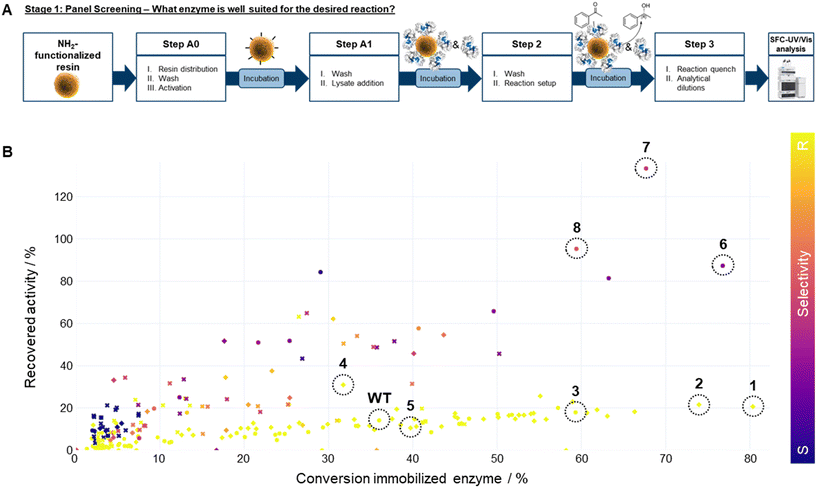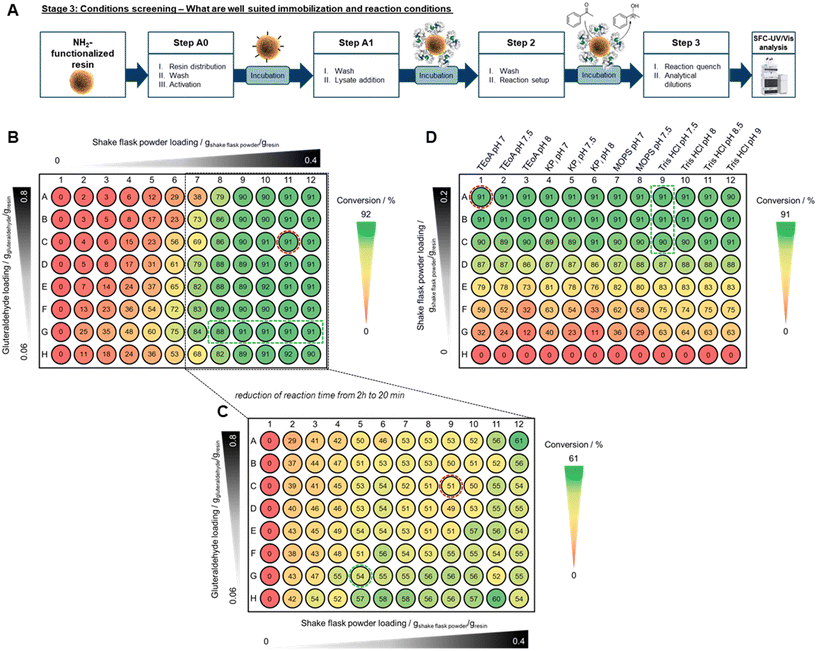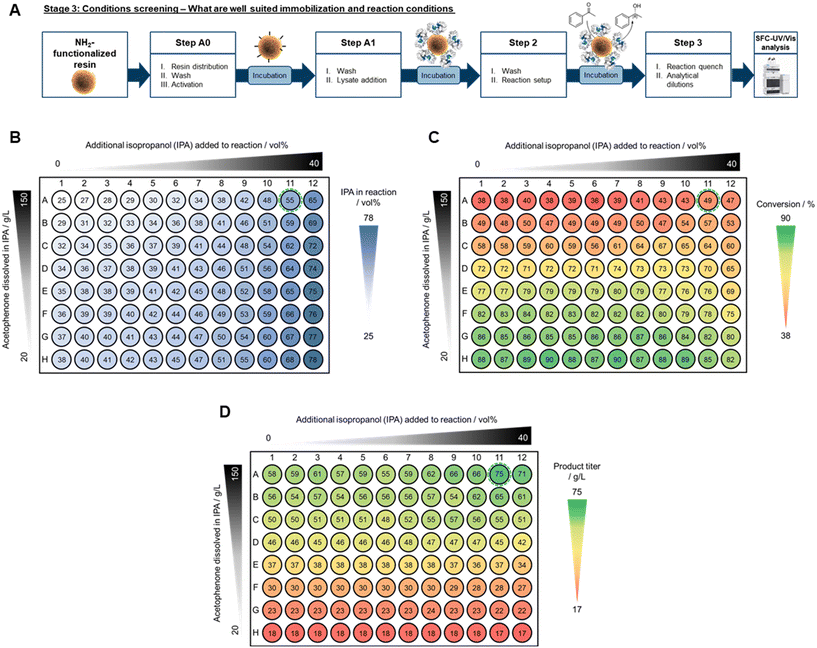Automated high throughput workflow for rapid implementation of immobilized enzymes in chemical process development†
Lukas
Schober
 ,
Philippe
Dreier
,
Philippe
Dreier
 and
Theo
Peschke
and
Theo
Peschke
 *
*
Chemical and Analytical Development, Novartis Pharma AG, 4056-CH Basel, Switzerland. E-mail: theo.peschke@novartis.com
First published on 22nd February 2024
Abstract
Despite known advantages of immobilized enzymes, their broad application in pharmaceutical drug manufacturing has not yet caught up. Limited access to commercially available immobilized enzymes on one side and time – and cost – consuming development of new processes on the other side have hampered their broader implementation so far. Herein, we present a walk-away high throughput workflow with state of the art robotic equipment that enables the rapid optimization and development of immobilized enzymes – ready to be scaled - and thus matching the need for speed in modern drug development. Following this workflow, we were able to identify an engineered ketoreductase which was >2-fold more active than the wildtype from L. kefir. Further optimization of the reaction and immobilization conditions lead to an additional 29-fold productivity increase from 0.36 to 10.6 gproduct genzyme−1 for the selected enzyme variant.
Introduction
Scientists are academically trained to seek for perfection and to understand all aspects of a problem while resolving it. At times, this can be contradictive to the need for speed in modern drug development, where the implementation success is closely related to the rapid availability of representative testing material. Biocatalysis has become a mature technology in organic synthesis of pharmaceutical drugs, especially when high selectivity and mild reaction conditions are required. They even became the new gold standard technology for the introduction of chiral alcohols and amines.1,2 Therefore, it is not too suprising that the pharmaceutical industry has identified biocatalysis as key technology to reach the ambitious, self-defined goal to increase sustainability without putting the economic feasibility of their production processes at risk.3 Despite many benefits of enzyme catalysis, there are several limitations when exposing their free form to the harsh reaction conditions used in drug substance (DS) synthesis. To overcome these limitations and improve enzyme properties, immobilization on a solid carrier is widely applied. Immobilization simplifies the recycling of the biocatalyst, enable their application in continuous flow and most important, avoids unwanted carry-over of proteins or DNA to the drug substance. There is a plethora of strategies to immobilize an enzyme, each with its own advantages and disadvantages, often dependent on the characteristics of the enzyme being used.4–6 Exploring these options can increase costs and lengthens the development process, which often hinders the implementation of immobilized enzymes in fast moving portfolio projects. Despite design of experiments (DOE) approaches being advantageous in reducing the number of experiments, assessing all critical parameters still requires thorough planning and conducting multiple iterative experiments.7 Lacking the availability of a suitable methodology that matches the “need for speed”, we developed a novel workflow to investigate our portfolio projects for opportunities. We herein report on an automated and reliable high throughput workflow allowing the rapid development of biocatalytic processes utilizing immobilized enzymes (see Fig. 1). The workflow is designed to be applicable with minimal prior knowledge on the immobilization of the desired enzyme and does not require pre-optimized conditions while being compatible with commercial carriers for process development available in bulk quantities. Furthermore, due to its modularity, steps can be easily skipped. In this regard, it also differs from previous approaches which are not fully streamlined for the needs of process development and do not focus on yielding starting points for robust and scalable biocatalytic processes.8,9 As ketoreductases (KREDs, EC 1.1.1.2) are widely used in the pharmaceutical industry,10 we applied them for the well-studied stereoselective reduction of acetophenone (1) to phenylethanol (R)-2 to prove the general applicability of our methodology. All reactions in our workflow are run in μL-scale, thus reducing costs, increasing the sustainability and allowing us to reduce the time per reaction from several hours to seconds by parallelization of experiments.Results and discussion
As KREDs are widely used in the pharmaceutical industry, they are an ideally suited enzyme class to develop methodologies to rapidly optimize their immobilization process. To cope with the high demand for the structurally complex and expensive KRED cofactor, nicotinamide adenine dinucleotide phosphate (NADPH), we used the in situ NADPH-regeneration via the KRED-catalysed isopropanol oxidation. Numerous techniques have been described for immobilizing KREDs and other enzymes.11–14 These reports underscore the challenge of identifying the perfect combination of carrier and enzyme, along with the corresponding conditions for immobilization.15 As a result, the primary aim of this study was to facilitate the screening process for a wide range of enzymes, carriers, and both reaction and immobilization conditions. The enzyme carriers, provided by Resindion and Purolite manufacturers, were considered highly suitable for industrial applications of immobilized enzymes. These carriers offer the advantage of being available with a range of surface modifications and can be produced at scales beyond laboratory quantities. Based on Purolite's instructions, a few different KREDs can be immobilized in parallel using solid phase extraction (SPE) tubes with frits for the particle retention in the washing steps (Fig. 2A).12 When challenging the described procedures with a typical request we receive in biocatalytic process development, such as finding the most active immobilized enzyme out of a collection of several hundred enzymes, it was quickly realized that this conventional approach was not suited. Even when parallelizing several experiments and only focusing on this effort it would have taken more than a month to screen 300 enzymes (Fig. 2A). Therefore, we set the objective for a novel workflow following the logical step by step approach in biocatalytic process development, however in a quicker manner. The first stage should allow the rapid and reliable identification of enzymes showing the desired performance after immobilization on a suited carrier. In a second stage, the approach should allow the testing of various resin types and their respective immobilization strategies to ensure the best suited technology is applied. Subsequently in stage 3, the identified immobilization conditions as well as the reaction conditions should be further optimized for the desired enzyme/resin combination. In the final stage 4, these optimized conditions should then be tested and validated in a scaled-up reaction setup. As development costs directly correlate to the number of consumables and time invested, all experiments in stage 1–3 should be downscaled without infringing the representativity when getting scaled up in stage 4.We therefore developed an automated μL-scale workflow allowing parallel processing of several experiments in a 96-well plate. For maximum compatibility and transferability to other lab activities, such as enzyme screening or protein engineering, a standard Biomek i7 liquid handling robot was used. For an automated protein content measurement and to calculate the immobilization yield, the Biomek i7 workstation was connected to a sealing device and a UV/Vis photometer via an integrated robotic arm (Fig. 2B).
Essentially, this automated workflow is conducting the same steps as if the immobilization procedure would be done by manual pipetting. The workflow is divided into 4 fully automated processing steps and 3 incubation steps (see Fig. 2C). A full integration of the complete workflow without any interruption was not envisioned to allow alternative usage of the liquid handlers during the incubation steps and to maximize flexibility in the workflows. Detailed experimental procedures of all the processing steps can be found in the ESI† chapter 3.2. to 3.5. including deck layouts for the developed methods. In brief, for NH2– or metal-chelating iminodiacetic acid (IDA)-functionalized resins a pre-activation step via cross-linking with glutaraldehyde or metal-loading was needed to be done in advance prior to the immobilization step (see Fig. 2C, step A0). As some pre-loaded metal-, epoxy-functionalized or hydrophobic porous particles do not need such a pre-activation step, an alternative processing step called B1 was programmed starting similar to the A0 step with an automated resin distribution and immediately continue with the washing and lysate addition. The automated resin distribution step avoids the time-consuming and error-prone mg-scale powder handling of the resins. Instead, resins were resuspended in one reservoir with water and then 25 mg were automatically transferred with the liquid handler to the individual wells (see Fig. 2C, step A0/B1). This approach was validated for amounts between 2.5 and 35 mg resin per well with excellent linearity across the whole range (see ESI†). Subsequently, the particles get automatically washed for 4-times. The washing steps are utilizing the fact that the particles quickly settle on the bottom of the well allowing them to be separated from the supernatant before the latter is removed during each washing cycle. Typically, particle diameter of <200 μm are suitable and the particles should settle at the bottom of the wells within 30 seconds. Any potential settling issue could be addressed by implementing centrifugation steps in between the washing steps, which was not necessary in our case. After the washing of the particles, fresh cell free lysate or resuspended enzyme powder was added for the immobilization step and incubated for 18 h at 25 °C in a shaker (see Fig. 2B, step A1/B1). To be able to calculate the recovered activity of each individual enzyme resin combination afterwards, the same enzyme solution was also transferred into a benchmark plate, which was then stored until the activity test at 4 °C. Prior to each incubation step, the plates were automatically sealed (see Fig. 2A). In the follow up step 2, the unbound enzyme was removed, and substrate mixture was added before the incubation step. The last step 3 was the automatic quench of the reaction and preparation of an analytical dilution plate which was then analysed by supercritical fluid chromatography coupled with UV/vis detection (SFC-UV).
To challenge our workflow, the described procedures were tested to identify the best enzyme candidate for the enantioselective reduction of acetophenone (1) towards (S)- or (R)-1-phenylethanol (S)-2 and (R)-2. In total, 283 unique KRED mutants from 4 Codexis KRED panel plates were screened in stage 1. The KREDs of Plate 1, 2 and 4 originated from Lactobacillus kefir,16,17 and therefore needed MgSO4 supplementation during induction, while KRED Plate 3 were supplemented with ZnSO4.18 Following our workflow, we evaluated all 283 KREDs for their conversion, their selectivity and their recovered activity after cross-linking them on an amino-functionalized carrier. All KREDs were tested as free and as immobilized enzymes in the same reaction setup to minimize experimental fluctuation. As shown in Fig. 3, KREDs with conversions up to 80%, high selectivity ranges from highly (S)- to (R)-selective (>99% ee) and a recovered activity from 0–120% could be identified. We observed two sub-populations of enzymes in the Codexis KRED panels unrelated to their plate origin: One showing excellent (R)-selectivity but low recovered activity (see yellow dots in Fig. 3) and a second one with higher recovered activity but mostly unselective or (S)-selective product formation. We adjusted the lysate concentration to 4% and achieved good differentiation amongst the mutants in terms of conversion. Subsequently, we also screened all plates at a 10-fold higher enzyme concentration of 40% lysate to ensure that the KREDs are capable to high product-related conversion >90% (see Fig. S1 and Table S5†). A list of the conversion, selectivity and recovered activity of all enzymes at 4% and 40% lysate, including those of the Codexis screening kits, can be found in the Table S7.† For further investigation we selected five top performing KREDs with excellent (R)-selectivity, in the following called KRED 1–5, and three non-selective variants with a high recovered activity called KRED 6–8. Notably, the best candidates already showed a >2-fold improvement in conversion compared to the wildtype enzyme (Fig. 3).
For the second stage of our workflow, the 8 KREDs were produced as enzyme shake flask powder (SFP) to evaluate their performance depending on the carrier type. As none of the KREDs has a His-Tag, we omitted testing any kind of metal loaded particles for affinity immobilization. However, given suitable particle properties, the workflow is applicable to other immobilization strategies such as adsorption on ionic or hydrophobic carriers or affinity immobilization for His-tagged enzymes (see Fig. 2A). A list of the tested resins in this work with additional information on supplier, carrier type, size, porosity, and linker-length are summarized in Table S1.† We focused our selection on 8 different amino- and 6 epoxy-functionalized carriers which also differ in porosity, size, and linker-length. The irreversible covalent enzyme binding of these carriers is favoured from a regulatory standpoint compared to non-covalent methodologies as this ensures the prevention of any potential carry over to the product.
As shown in Fig. 4, rather independent from the carrier type, the highest conversion was detected among KRED 1–5, while the highest recovered activities amongst KRED 6–8. All KREDs showed a higher activity when immobilized on an amino carrier compared to an epoxy functionalized one (see also Fig. S5†). Amongst the tested resins, short chain linkers (ECR83XXF line) performed better than the corresponding long chain linkers (ECR84XXF line and HAXXX/S line). Regarding the porosity – higher conversions were obtained for higher porosities. However, due to their lower physical stability, the higher porosity of the particles also limits their applications to packed bed reactions in continuous flow. To remain flexible in terms of the applied process technology and as batch process development is still the more straightforward manufacturing option, we decided to continue with KRED 2 on process stable ECR8304F resins. Unfortunately, we have used this resin type already for the step 1 enzyme screening based on our pre-knowledge on L. kefir KREDs, thus the stage 2 resin screening did not lead to any changes and therefore improvement of our biocatalytic process. In the future, we would therefore skip this development step for highly related KRED variants. However, it should be kept for novel enzymes or KREDs with a lower sequence similarity or in case more diverse approaches, such as affinity immobilization, are added.
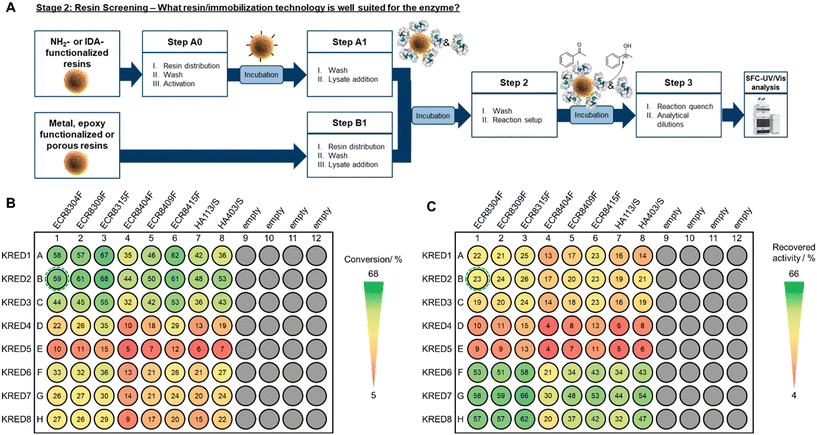 | ||
| Fig. 4 Stage 2 resin screening – what resin and which corresponding immobilization approach is well suited for the KREDs showing the highest reduction of acetophenone (1) (A) Schematic flow chart of the different automated steps conducted. (B) Conversion and (C) recovered activity of immobilized KRED candidates 1–8 on amino-functionalized carriers for the enantioselective reduction. Recovered activity is calculated by comparison of product-related conversion of immobilized enzyme vs. free enzyme and does not take immobilization efficiency into account. KRED 1–5 are highly R-selective, while KRED 6–8 are non-selective (see also Fig. 3). The identified best KRED resin combination for a flexible process development is highlighted with a green dotted circle around the well. | ||
The third stage of the workflow was used to optimize the immobilization procedure in regard of the glutardialdehyde (GA) concentration, enzyme loading, buffer types and the pH. Usually, several of these parameters are interdependent and identifying the best combination can be time consuming. To address this challenge, we used a 2D parameter screening approach. Thereby 2D gradients were generated across the 96-well plates by serial dilutions of the stock solutions (see ESI for detailed methodology). In the first set of experiments, the buffer system was fixed to 50 mM TEoA, pH 7.5 whereas the GA gradient was varied along the x-axis from 0.0063 and 0.8 g gresin−1 and the enzyme gradient along the y-axis from 0 to 0.4 gSFP gresin−1. Despite no further conversion increase was observed above 0.05 gSFP gresin−1, the enzyme loading sweet spots could be narrowed to a concentration ≥0.023 gSFP gresin−1 and around ∼0.0125 gGA gresin−1 (see Fig. 4A, conditions based on the recommendations of the supplier are highlighted with a red dotted line around the well; the optimized with a green one). To circumvent the stalling of the reaction, the plates were re-screened with a shorter reaction time of 20 minutes instead of 2 h and in a narrower enzyme loading range (see Fig. 5B). The experiment confirmed that a further increase of the enzyme loading above 0.053 gSFP gresin−1 does not further improve the conversion. In a third experiment, different buffer systems and pH values had been screened at varying enzyme concentration (see Fig. 3C). Despite only minor differences amongst them, the enzyme immobilization buffer 50 mM Tris HCl pH 7.5 performed best and was set as the new standard.
As costs are an important factor in the decision making to find the ideal process condition, we calculated the predicted costs for each condition based on the material costs of the consumables (2D-plot shown in Fig. S7†). While this purely cost driven view of one step is useful to take a more informed decision, it is also simplifying the real cost as low conversion values normally go along with a more tedious and costly workup of the reaction mixture. Therefore, the chosen conditions are a compromise of all these aspects. The new conditions allowed significantly lower material costs due to an 8-fold reduction of glutaraldehyde and >2.5-fold regarding the KRED while keeping high product related conversion.
In the second part of the condition screening, the improved immobilization conditions were used to produce immobilized KRED 2 which was then tested under different reaction conditions. Despite mimicking substrate feeding or in situ co-product removal on small scale is unrealistic, parameters, like varying (co)-substrate or cofactor concentrations, buffer-pH or types are well suited and due to the high throughput even preferentially tested in small scale. In a first experimental setup, we varied two highly interdependent parameters, the substrate concentration of acetophenone (1) and the co-substrate/co-solvent isopropanol. Making an educated prediction of the optimal concentration is not trivial. High concentration of isopropanol will push the reaction towards the desired product but also potentially decrease the enzyme stability and thus influence the overall productivity of the process. As the substrate had to be dissolved in isopropanol as well, the isopropanol gradient was diagonal over the plate from A1–H12 (see Fig. 6A). As presented in Fig. 6B and C the immobilized KRED 2 showed the highest product titer with a decent conversion (49.4%) after only 2 h at a loading level of 150 g L−1 acetophenone and 55 vol% (7.1 eq.) isopropanol.
The cofactor NADPH can be a significant cost contributor to a biocatalytic step. Therefore, stage 3 of the workflow was also used to investigate whether the necessary amount of cofactor in correlation with the corresponding buffer system can be further decreased (see results in Fig. S6†). The investigation revealed that the addition of NADP to the reaction buffer did not lead to higher conversion values. This indicates not only that sufficient cofactor being present in the crude shake flask powder but also that it remains firmly bound to the enzyme during immobilization and subsequent washing. The buffer screening of triethanolamine (TEoA), potassium phosphate (KPi), 3-(N-morpholino)propanesulfonic acid (MOPS), tris(hydroxymethyl)aminomethane (Tris) buffers at pHs ranging from 7–9 resulted in a similar productivity for all tested buffer systems (see Fig. S5†). To simplify the process control and sourcing, it was decided to use the same buffer system as in the immobilization step, Tris HCl pH 7.5.
In the final stage 4, we investigated whether the findings based on our small-scale high throughput method are scalable. Therefore, we scaled up the plate-based immobilization procedure 80-fold to a 2 g-scale using Solid phase extraction (SPE) tubes. Two different batches of immobilized KRED2 were prepared, one following typical literature conditions,12 the other our optimized immobilization conditions based on stage 3A (see Table 1). Both immobilization batches were then tested monitoring the conversion for 24 hours under typical reaction conditions based on literature12 as well as with our optimized reaction conditions identified in step 3B. Indeed, the findings from stage 3A were confirmed, and very similar conversion were observed for both conditions despite the optimized immobilization conditions are applying 3 times less enzyme and 6 times less glutaraldehyde (ESI† Table S12). Comparing the literature conditions for immobilization and the reaction conditions with those identified in stage 3A and 3B (higher substrate loading, no cofactor supplementation and higher isopropanol concentration; see Table 1) most key performance indicator (KPI) in process development such as catalyst productivity, product titer, costs and sustainability improved (see Table 1). The conversion was the only KPI that deteriorated, which however is a known phenomenon at increased substrate loadings. The inherent equilibrium problem associated with the coupled-substrate approach can be simply overcome by acetone removal with a lower atmospheric pressure in the reaction vessel.19–21 These results clearly show that our workflow allows the rapid optimization of scalable biocatalytic processes comprising immobilized enzymes.
| Parameter | Literature conditions12 | Optimized conditions | |
|---|---|---|---|
| a The inherent equilibrium problem associated with the coupled-substrate approach can be simply overcome by acetone removal with a lower atmospheric pressure in the reaction vessel.19–21 b A more detailed time dependent plot of the catalyst productivity can be seen in Fig. S8.† c Absolute cost calculation was based on prices from October 2022 and heavily depend on market situation and scale. The numbers should be only used for relative orientation. Further details for the underlying calculation can be found in Table S13.† d Process mass intensity (PMI) is a mass-based metric to evaluate the green credentials of an individual reaction. The PMI was calculated only for the biocatalytic reaction without considering any downstream processing/isolation. | |||
| Conditions | Immobilization buffer | 75 mM TEoA pH 7.0 | 75 mM Tris HCl pH 7.5 |
| Gluteraldehyde loading | 0.08 g gResin−1 | 0.0125 g gResin−1 | |
| Enzyme loading | 0.156 g gResin−1 | 0.053 g gResin−1 | |
| Acetophenone concentration | 12 g L−1 (0.1 M) | 150 g L−1 (1.25 M) | |
| NADP concentration | 0.5 g L−1 | 0 g L−1 | |
| Isopropanol concentration | 20 vol% | 55 vol% | |
| Reaction buffer | 75 mM TEoA pH 7.0 | 75 mM Tris HCl pH 7.5 | |
| Key Perfomance indicator (KPI) | Conversion | 92% | 73%a |
| ee | >99% | >99% | |
| Catalyst productivityb | 0.35 gproduct genzyme−1 | 10.2 gproduct genzyme−1 (29-fold increase) | |
| Product titer | 11 g L−1 | 111 g L−1 (10-fold increase) | |
| Reagent costsc | High | Low (19-fold decrease) | |
| Sustainability based on PMId | 102 kg kg−1 | 9.7 kg kg−1 (11-fold decrease) | |
Conclusions
In summary we developed a robust high throughput immobilization workflow to rapidly identify suitable and scalable conditions for enzyme immobilization and subsequent initial assessment for process development. Using state-of-the-art automated workstations, it is fully compatible to standard plate-based molecular biology and biochemical workflows – used for example in protein engineering. The whole setup is automizing all solid and liquid distributions and mixing steps and most of the sealing steps limiting the manual operations to stock solution preparation, transport to the incubators and some sealing/de-sealing steps if needed. This frees up valuable time for lab associates and minimizes deviations and errors in experiments. Currently, we are routinely using this approach within different projects in our effort to create competitive and sustainable biocatalytic processes. Our data-rich approach creates the opportunity to learn from what has been done and adjust the individual experiments based on the needs of the project. Moreover, the high throughput enables a fast and very broad screening of conditions – even going beyond of what may be considered suitable and allows the elucidation of trends across wide experimental spaces. As a result, one can identify conditions that might not even be tested in a more traditional process development approach. In our case we were able to significantly decrease the glutaraldehyde concentration in the initial activation, precisely determine the optimal enzyme concentration for immobilization, use no additional cofactor in the reaction while using a very high concentration of the substrate and co-substrate. The implementation of biocatalysis in pharmaceutical processes is often hampered by the slow and costly development and the availability of representative testing material. Our novel approach allows to develop without prior knowledge a scalable process for immobilized enzymes in less than a month. It offers a high flexibility in regards of the enzyme types and resin materials. However, the latter one needs to be within the technical limitations of the liquid handling robots and particle properties need to allow a rapid settling in solution. Nearly all tested immobilization resins fulfilled these requirements. However, Purolite's adsorption resins ECR1090M, ECR1030M and ECR8806, with a high particle diameter of >300 μm, resulted in clogged pipette tips and were therefore not compatible with our standard tips. Alternatively, insufficient settling properties can be easily overcome by the usage of filtration microplates and gently applying centrifugation or vacuum.8 We therefore believe that our approach is bridging an existing gap and can therefore pave the way for an even broader implementation of immobilized enzymes in industry.Author contributions
L. S. and T. P. came up with the conceptualization and have written the original draft. L. S., T. P. and P. D. edited and reviewed the draft. L. S. and P. D. established the robotic protocols. L. S. carried out the experimental work, data curation and formal analysis.Conflicts of interest
There are no conflicts to declare.Acknowledgements
We thank Dominique The Trung Nguyen, Nhat Quang Nguyen Trung, Herve Koehl and Heike Ertle for analytical and Thierry Schlama for scientific support. Special thanks to Kirsten Schroer and Laura Leemans for proof reading of the manuscript.Notes and references
- S. Lütz, Angew. Chem., Int. Ed., 2013, 52, 7355 CrossRef.
- R. A. Sheldon and D. Brady, ChemSusChem, 2019, 12, 2859–2881 CrossRef CAS PubMed.
- S. Wu, R. Snajdrova, J. C. Moore, K. Baldenius and U. T. Bornscheuer, Angew. Chem., 2021, 60, 88–119 CrossRef CAS PubMed.
- J. M. Bolivar, J. M. Woodley and R. Fernandez-Lafuente, Chem. Soc. Rev., 2022, 51, 6251–6290 RSC.
- R. A. Sheldon, A. Basso and D. Brady, Chem. Soc. Rev., 2021, 50, 5850–5862 RSC.
- L. Leemans Martin, T. Peschke, F. Venturoni and S. Mostarda, Curr. Opin. Green Sustainable Chem., 2020, 25 DOI:10.1016/j.cogsc.2020.04.011.
- J. A. Selekman, J. Qiu, K. Tran, J. Stevens, V. Rosso, E. Simmons, Y. Xiao and J. Janey, Annu. Rev. Chem. Biomol. Eng., 2017, 8, 525–547 CrossRef PubMed.
- M. B. Spano, B. H. Tran, S. Majumdar and G. A. Weiss, J. Org. Chem., 2020, 85, 8480–8488 CrossRef CAS PubMed.
- K. Rodríguez-Núñez, C. Bernal and R. Martínez, Int. J. Biol. Macromol., 2021, 170, 61–70 CrossRef PubMed.
- S. P. France, R. D. Lewis and C. A. Martinez, JACS Au, 2023, 3, 715–735 CrossRef CAS PubMed.
- T. Peschke, M. Skoupi, T. Burgahn, S. Gallus, I. Ahmed, K. S. Rabe and C. M. Niemeyer, ACS Catal., 2017, 7, 7866 CrossRef CAS.
- A. Basso, M. S. Brown, A. Cruz-Izquierdo, C. A. Martinez and S. Serban, Org. Process Res. Dev., 2022, 26(7), 2075–2084 CrossRef CAS.
- A. I. Benítez-Mateos, E. San Sebastian, N. Ríos-Lombardía, F. Morís, J. González-Sabín and F. López-Gallego, Chem. – Eur. J., 2017, 23, 16843 CrossRef PubMed.
- G. Rulli, M. Heidlindemann, A. Berkessel, W. Hummel and H. Gröger, J. Biotechnol., 2013, 168, 271 CrossRef CAS PubMed.
- T. Heinks, N. Montua, M. Teune, J. Liedtke, M. Höhne, U. T. Bornscheuer and G. Fischer von Mollard, Catalysts, 2023, 13, 300 CrossRef CAS.
- C. Ching, J. M. Gruber, G. W. Huisman, E. Mundorff and L. M. Newman, 2018, US7820421.
- E. L. Noey, N. Tibrewal, G. Jiménez-Osés, S. Osuna, J. Park, C. M. Bond, D. Cascio, J. Liang, X. Zhang, G. W. Huisman, Y. Tang and K. N. Houk, Proc. Natl. Acad. Sci. U. S. A., 2015, 112, 7065 CrossRef PubMed.
- A. Gupta, A. Tschentscher and M. Bobkova, 2007, EP2004838B1.
- P. Tufvesson, C. Bach and J. M. Woodley, Biotechnol. Bioeng., 2014, 111, 309–319 CrossRef CAS PubMed.
- S. J. Calvin, D. Mangan, I. Miskelly, T. S. Moody and P. J. Stevenson, Org. Process Res. Dev., 2012, 16, 82 CrossRef CAS.
- K. Goldberg, K. Edegger, W. Kroutil and A. Liese, Biotechnol. Bioeng., 2006, 95, 192–198 CrossRef CAS PubMed.
Footnote |
| † Electronic supplementary information (ESI) available. See DOI: https://doi.org/10.1039/d3re00704a |
| This journal is © The Royal Society of Chemistry 2024 |

